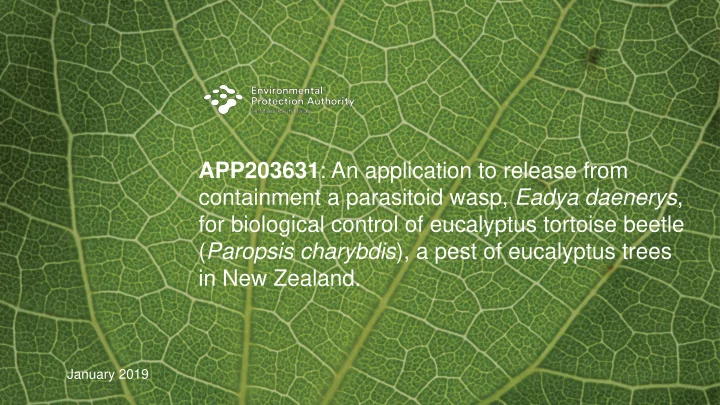

APP203631 : An application to release from containment a parasitoid wasp, Eadya daenerys , for biological control of eucalyptus tortoise beetle ( Paropsis charybdis ), a pest of eucalyptus trees in New Zealand. January 2019
The application 2 Scion lodged an application with the EPA on 18 September 2018 seeking approval to release Eadya daenerys , as a biological control agent for the eucalyptus tortoise beetle, Paropsis charybdis . The application was publicly notified. The EPA received 27 submissions: 21 submitters supported the application and 6 opposed the application.
Eadya daenerys Paropsis charybdis 3 Parasitoid wasp Eucalyptus tortoise beetle (ETB) 3 mm 3 mm
Eucalyptus 4 60 to 75% at risk (Symphyomyrtus) 2% forestry industry Asset value $671 million >80% in only 4 regions
Risk/Benefits assessment 5 We assessed the risks and benefits of bringing the parasitoid wasp into New Zealand, assuming the successful establishment of self-sustaining populations. We assessed the risks and benefits to: • the environment, • market economy, • people and communities, • Māori and their relationship with the environment, and • public health.
Environmental benefits 6 Reduced use of pesticides: • Current rapid effective and economical option is broad spectrum chemicals • Plantations certified by the Forest Stewardship Council Improved biodiversity: • Tree monocultures > Abandoned or degraded pastures • More flowers would attract more nectar feeders, insects and insectivores • But successive short rotations and not specific to eucalyptus
Environmental benefits 7 Impact on ecosystem services: • Increase carbon sequestration • Decrease nitrate leaching • Provide more habitats • But not specific to eucalyptus The level of benefits vary from low to medium with localised benefits to regions where large eucalypt ecosystems exist.
People and communities benefits 8 Improve air and water quality Recreational activities Increased employment The level of benefits from the release of the parasitoid wasp would be low to medium .
Economic benefits 9 Increase productivity: • Better growth and healthier trees • Increase livestock survival rates, pasture productivity Reduce pesticides costs: • Chemical control costs between $1.0 and $2.6 million/year • No ongoing cost with the BCA Maintain FSC certification: • Emergence of a green building markets • Higher price on the market
Economic benefits 10 Impact on ecosystem services: • $11 million per year for non-market value The level of benefits on New Zealand’s market economy from the release of E. daenerys to be low to medium .
Environmental risks Impact on native beetles: 11 • 40 species, uncommon • Allocharis near tarsalis Impact on beneficial BCA : • 6 weed BCA selected and tested by Scion • No viable hosts Impact on the ecosystem and food webs: • Reduction of prey • Benefit other pest species • Competition for nectar • Hybridisation We consider the level of risks to be negligible .
Economic risks 12 Impact on beneficial BCA The overall level of risks on New Zealand’s market economy from the release of E. daenerys is considered to be negligible .
Summary of our assessment Potential outcomes Conclusion Overall level of environmental benefits Low / medium Overall level of economic benefits Low / medium Overall level of beneficial effects on people and communities Low / medium Overall level of environmental risks Negligible Overall level of economic risks Negligible
Relationship of Māori to the Environment 14 Kaupāpa Kura Taiao concluded that the potential risks to Māori interests appear to be acceptable. However, further work may be needed to better understand the potential indirect impacts of the application and to support on-going engagement between the applicant and Māori.
Minimum standards 15 We assessed the release of Eadya daenerys against the minimum standards in the HSNO Act. Our assessment concludes that the biocontrol agent meets the minimum standards. Recommendation Our assessment has found that the benefits of releasing E. daenerys outweigh any identified risks or costs. We therefore recommend that the application be approved.
For more information contact: General enquiries Phone +64 4 916 2426 Fax +64 4 914 0433 info@epa.govt.nz
Recommend
More recommend